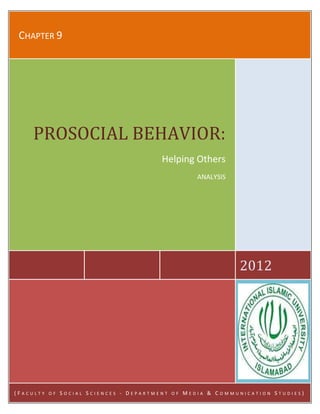Prosocial Behavior helping others - Analysis
•
1 gostou•722 visualizações
Denunciar
Compartilhar
Denunciar
Compartilhar

Recomendados
Recomendados
Mais conteúdo relacionado
Mais procurados
Mais procurados (20)
ALTRUISM & COOPERATION (Psych 201 - Chapter 14 - Spring 2014)

ALTRUISM & COOPERATION (Psych 201 - Chapter 14 - Spring 2014)
Semelhante a Prosocial Behavior helping others - Analysis
Semelhante a Prosocial Behavior helping others - Analysis (20)
Prosocial behaviour and altruistic Behaviour Determinants

Prosocial behaviour and altruistic Behaviour Determinants
Social Perception – perceiving and understanding others - Analysis

Social Perception – perceiving and understanding others - Analysis
Attitudes evaluating and responding to the social world - Analysis

Attitudes evaluating and responding to the social world - Analysis
Groups and Individuals the consequences of belongings - Analysis

Groups and Individuals the consequences of belongings - Analysis
Unit 6. Social Identities: The self and/in Interaction

Unit 6. Social Identities: The self and/in Interaction
The Behavior Therapy For Children With Attention Deficit...

The Behavior Therapy For Children With Attention Deficit...
Mais de Hina Anjum
Mais de Hina Anjum (20)
Aggression its nature, causes, and control - Analysis

Aggression its nature, causes, and control - Analysis
Social Influence changing others’ behavior - Analysis

Social Influence changing others’ behavior - Analysis
Último
Mehran University Newsletter is a Quarterly Publication from Public Relations OfficeMehran University Newsletter Vol-X, Issue-I, 2024

Mehran University Newsletter Vol-X, Issue-I, 2024Mehran University of Engineering & Technology, Jamshoro
Último (20)
UGC NET Paper 1 Mathematical Reasoning & Aptitude.pdf

UGC NET Paper 1 Mathematical Reasoning & Aptitude.pdf
Jual Obat Aborsi Hongkong ( Asli No.1 ) 085657271886 Obat Penggugur Kandungan...

Jual Obat Aborsi Hongkong ( Asli No.1 ) 085657271886 Obat Penggugur Kandungan...
Mixin Classes in Odoo 17 How to Extend Models Using Mixin Classes

Mixin Classes in Odoo 17 How to Extend Models Using Mixin Classes
General Principles of Intellectual Property: Concepts of Intellectual Proper...

General Principles of Intellectual Property: Concepts of Intellectual Proper...
Basic Civil Engineering first year Notes- Chapter 4 Building.pptx

Basic Civil Engineering first year Notes- Chapter 4 Building.pptx
ICT role in 21st century education and it's challenges.

ICT role in 21st century education and it's challenges.
On National Teacher Day, meet the 2024-25 Kenan Fellows

On National Teacher Day, meet the 2024-25 Kenan Fellows
Prosocial Behavior helping others - Analysis
- 1. Submitted To: Ma’am Irum Abbasi Submitted By: Hina Anjum Submitted On: Sept. 27, 2012 CHAPTER 9 2012 PROSOCIAL BEHAVIOR: Helping Others ANALYSIS ( F A C U L T Y O F S O C I A L S C I E N C E S - D E P A R T M E N T O F M E D I A & C O M M U N I C A T I O N S T U D I E S )
- 2. Prosocial Behavior: Helping Others November 21, 2012 A Formal Analysis of ‘Prosocial Behavior’ The focus of the present chapter is to understand the role of bystanders’ response to nonverbal cues of other bystanders, the processes of social comparison, attributions, self-concept, similarity of victim and bystander, affective state and helping, genetics and helping. Prosocial behavior refers to the actions by individuals that help others with no immediate benefit to the helper. Helping can be increased by empathy-emotional reactions that are focused on other people and include feelings of compassion, sympathy and concern. The origin of Prosocial Behavior includes three different views i.e. empathy-altruism hypothesis that leads us to help others in need, negative state relief hypothesis that leads us to help others in need to reduce negative feelings in ourselves and empathy joy hypothesis that leads us to engage ourselves in prosocial behavior to have a positive impact on others. Prosocial behavior stems from several different motives and helps us attain many different goals. So this suggests that people have good reasons for offerings to others. Failure to act often stems from the belief that someone else will do it. When faced with emergency one must notice that something unusual is happening, interpret the event as an emergency, accept responsibility for helping, decide that he has the knowledge or skills needed to help and then decide to actually help. The tendency to help or not help depends in part on decision made at these five crucial steps. The tendency to help others is not equal across different people. In fact, it is strongly influenced by emotions, empathy, and by several aspects of personality. We are more likely to help others who are similar to ourselves than others who are dissimilar. Prosocial behavior is found to be influenced in both positive and negative ways by many aspects of the situation. Empathy is an important determinant of helping behavior. Several aspects of personality also influence helping including belief in a just world, social responsibility, internal locus of control, and low egocentrism. People volunteer to provide help on a long-term basis as a function of various selfish and selfless motives. People volunteer for many reasons such as to express or act on important values, to learn more about world, to develop psychologically, to gain career-related experience, to strengthen social relationships and to reduce negative feelings. People can be differentiated in terms of their primary motivation when faced with making a choice that involves relatively moral versus relatively immoral alternatives. The three primary motives are self-interest, moral integrity, and moral hypocrisy. People make it seem as if they are acting in a moral way, but their actual behavior is based on self-interest. So no people do so much harm as those who go about doing good.
